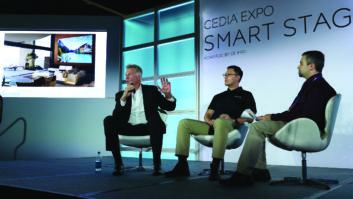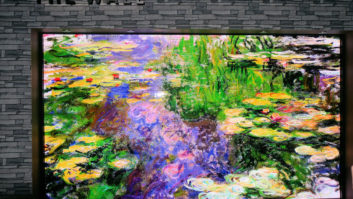After the unsettling events of last September and the obvious effect they have had on many segments of our economy, it is not unfair to say that an unusually large number of eyes were focused on Las Vegas in early January. It wasn’t to gawk at showgirls or new hotels; it was to see how the annual International Consumer Electronics Show would fare. Would exhibitors and attendees alike stay home in large numbers as they had only weeks earlier at Comdex and the Western Cable Show? Would the massive investment in the new South Hall exhibit area end up having been better spent to create a bowling alley? To say that there was nervousness in many camps is an understatement.
Fortunately, the headline news out of CES is all good. Good for the economy in that exhibitors, both domestic and international were there filling a record amount of space. It was good for the consumer electronics industry, for while the total attendance was down, all reports have it that the buyers who did come to the show were more than just tire kickers. And it was good for the clients of custom installation, as there is a wide range of new products coming in the market that fill a variety of installation and systems needs. This all comes as very good news for the residential systems professional, as all indications are that the products and services we provide are right at the sweet spot of the demand curve in consumer electronics. A quick summary was that everyone was ready to knuckle down and get back to business. “On with the show” could have been a very appropriate slogan for CES 2002, so without further ado, that is exactly what we will do.
Without a doubt, DVD and digital television are the engines that are driving the bulk of consumer electronics activity, in turn resulting in upgrades to audio systems for new receivers or processors, amplifiers and speakers. The parallel growth path of the two technologies is an interesting one. DVD has been driven down to commodity pricing and high volume while digital television products are growing in broad consumer acceptance but still relatively high priced. Walking around CES, it was clear that, along with networked products, these two engines will continue to power our world in the year ahead.
Yes, the vast majority of DVD sales are now at sub-$199 pricing, but there is plenty of room at the top for those of us who deal in more sophisticated DVD products, including progressive scan, DVD-Audio and SACD. Indeed, CES observers made it clear that in the absence of inexpensive set-top decoders, the lack of cable carriage for HD signals and the still relative scarcity of HD over-the-air (OTA) signals and programming make it clear that the vast majority of “HD-ready” displays are being used with DVD as the only high-quality signal source.
Clearly, there is a moral in there for those who sell and install satellite systems, as in many areas they still are the most reliable source of HD signals. If you install a high-resolution device, a new progressive scan DVD player, a DirecTV, EchoStar or 4D receiver and perhaps even a high-resolution gaming console such as XBox (just warn the clients about the potential for phosphor burn!) should be an easy sell.
As to the DVDs you will be selling, don’t look to any with 1394 connectivity quite yet. While Denon did introduce a high-end DVD/DVD-Audio player with a proprietary digital link to its new high-end A/V receiver, there is still no evidence that we will see 1394 outputs for transmission of either audio or video from DVD players to receivers or processors until late this year, if then. In the mean time, concentrate on units with higher-end digital processing that many of the brands are making available for the specialty market, and emphasize the sonic benefits of DVD-A and multichannel SACD.
Both of those last two formats seem to be serious about fighting it out for market share, and a number of new players were introduced on both sides of the format battle. If your customers are looking for both formats but want a single machine, a low-priced “universal” machine playing DVD-A and SACD will be available this spring from Apex at $399, while Pioneer is taking the high road with a deluxe, and combo machine at $1,200. At the same time, some of the new players are introducing bass management for the analog outputs of the high-resolution audio signal. But until things get ironed out on the digital connection front, or more receivers and processors add internal bass management for their “5.1 channel direct” inputs, be sure that those inputs are not only there, but that you have engineered the system to accommodate the low pass/high pass requirements of the speaker complement.
That other DVD format battle, with “only” five separate formats vying for acceptance as “the” recordable and recordable/re-writable standard, we still have DVD-RAM, DVD-R, DVD-RW, DVD+R and DVD+RW. The relative merits of each have been played out here often enough, and there was no major movement from either side at CES. As with DVD-A vs. SACD, everyone is sticking to their guns in promoting the value and virtues of their approach. There were no new major players for any of the formats with the exception of the promise of a sub-$500 DVD+RW machine from Apex later this year. Some of the major players such as Sony and Thomson are still sitting on the sidelines despite professed format alliances, and the “dual format” machine Sony promised us last year at CES for release this spring was nowhere in sight.
Thinking of the connection between active DVD use and digital television, it would be natural to ask about the status of high-def DVD players. No fewer than five were on display at CES, (LG/Zenith, Panasonic, Pioneer, Samsung and Toshiba–and those were only the HD-DVD recorders), all using blue lasers. All of the pictures were stunning. But despite continued advancements in blue laser technology, this is still something that appears to be at least 18 to 36 months away from practicality in terms of product cost and reliable life-span.
More importantly, there is the potential for a major shift in the HD-DVD sands as proposals are circulating to use advanced compression technology to store a full feature film in 1280 x 720 resolution on side of a conventional “DVD-9” disc. In theory, this is a very logical approach, and it remains to be seen if it will overcome the inertia blue laser has gathered up as the goal for HD-DVD over the past few years. For now, HD-DVD is still something a bit out in the distance.
One might think that the continual push-back for delivery of HD-DVD would encourage manufacturers to introduce more D-VHS players as an interim alternative. However, CES saw no one join JVC and Mitsubishi as the only brands offering that product. A bright note, however, was sounded by a post-CES announcement that HDNet founder and resident HDTV cheerleader-in-chief Mark Cuban is investigating the possibility of offering some pre-recorded programming in the D-VHS format. That would certainly boost the fortunes of the format, and we will report further on this as more news develops.
For those looking to something other than DVD as a playback source for the digital sets everyone is buying, the choices are temporarily narrowing. Some manufacturers are selling through their current HDTV set-tops without introducing replacements at this time. (Expect to see those for the first time during the spring line show season, with shipments possibly beginning in the fall.) Only Samsung showed a new STB, and again, anyone looking for 1394 connections will have a hard time.
Satellite reception is, literally, a large part of the HDTV picture, but don’t look for too much action on that front until the ultimate outcome of EchoStar’s planned acquisition of DirecTV is determined. Even DirecTV stalwart RCA is eliminating DirecTV capability from some of its new HDTV integrated models,though RCA officials say that is not connected to the pending merger. Here again, depending on your specific vendor list, one important take-away from CES is not so much of which new products to order, but which current models you may need to get an assured supply of for the next few months. However, in all the noise over HD and satellite, RCA is maintaining their best-selling DTC-100 until a replacement arrives. The final digital program source that could conceivably be used with an HDTV display is a hard drive recorder, and the technical practicality of HD-PVRs has long been established. There is a limited, yet clear, market for this type of device, yet only EchoStarhas any firm plan to bring one to market (later this year), and the capability is part of the future feature set of the new Moxi system (more about that later). In the mean time, when it comes to HD sources, it is a question of “real-time or no-time”. Don’t let the dearth of practical HD sources get you down. First of all, with the May 1 mandatory “turn-on” date of all commercial stations fast approaching, things are bound to change quickly in the months just ahead. As you read this, the Winter Olympics is available on NBC and HDNet, and all of the major networks have at least some HD programming in prime time. No one really expects every station to meet the deadline and some will undoubtedly be granted extensions. However, the growing universe of stations will undoubtedly begat more HD displays in consumers homes, which in turn will hopefully convince broadcasters to offer more HD programming, which will be seen using all those new STBs we’re hoping for along with increased cable and DBS carriage of HD.
So much for sources…what will people be watching this digital programming on? Based on the products on display at CES, it will be an ever-widening mix of display technologies. CRT still remains the mainstay for digital rear-projection models, with pricing finally dropping to the point where parity with analog sets is close, and within the 12 to 18 months it is not unfair to say that the days of the analog rear projector may be numbered. The choice of models is broad, and any clients still holding out from installing a DTV set simply no longer have an excuse. That other bastion of CRT, the direct-view television, took a very interesting turn at CES. Joining the sets from mainstream brands were models displayed at the show to attract buyers looking for OEM branding on a direct-view set. Made mostly in Mainland China by powerhouse volume manufacturers with very unfamiliar names, you may soon see these budget sets offered to you as second source products under the some familiar names such as Advent, Jensen and others. It remains to be seen how these sets stand up to the majors when it comes to picture quality and reliability, but there is no denying the impact that low-cost DVD players from Apex and others have had on the market. If nothing else, when you are offered these sets, you owe it to yourself to see if they fit a niche for “second-room” HD monitors, placed in a gym, guest room or other areas where your client prefers not to spring for a major-brand product. If nothing else, the availability of these sets in the popular-priced market and through mass-distribution channels will at least broaden the HDTV installed base. It will also, hopefully, convince programmers, networks and cable operators to pay more attention to HD.
Back in our end of the world, CES was filled with high-end displays using a variety of fixed-pixel imaging technologies. Tabletop DLP-based sets were everywhere, in sizes starting at the 43-inch mark. Note that some of these are only 480P sets while others are true 720P, but given the broad acceptance of DLP as a rear-projection engine at CES you should have no problem choosing from brands and manufacturers. With pricing dropping rapidly and DLP sets available under $4,000, wide-screen, narrow-depth digital displays are a clear reality at a solid new price point.
As interesting, DLP is no longer alone in the fixed-pixel rear-screen market.
Perhaps one of the “under-covered” stories at CES was the emergence of LCoS and LCD-based sets to compete with DLP for the RPTV market. A good example is the wider application of JVC’s D-ILA technology, soon to be used in a 36-inch-wide monitor from Viewsonic at $6,999 and a 50-inch-wide model from Apex to be priced under $8,000. RCA is finally shipping their LCoS 50-inch-wide set, and it will see competition this fall from a 57-inch-wide LCoS set from Toshiba and a LCoS set from Hitachi.
Even traditional transmissive LCD, perhaps counted out by some for RPTV use, is making a comeback. Joining the LCD-based set introduced by Sony at CEDIA EXPO will be a 40-inch-wide model at $3,499 and a 45-inch-wide model from Panasonic. Zenith will field a 60-inch-wide LCD set at $6,999 as well as a 52-inch-wide model, and even Daewoo will have a 60-inch-wide LCD based unit this spring at $7,999. LCD was making news with more than rear projectors, as Samsung, Sharp and Zenith led the pack in offering broad selections of LCD models, including 30-inch-wide, HDTV-capable models that will likely price out in the $6,000 range. Samsung’s 40-inch-wide LCD, billed as the world’s largest as we reported from Comdex, was on display in a form evidencing that it is getting closer to production, but don’t expect to pay less for this giant that comparable PDP.
PDP? Once an exotic rarity, it is not quite a commodity yet, but pricing is moving ever closer to the magic “$100-per-inch” mark sought after as the Holy Grail of plasma manufacturers. Once limited in size and functionality, plasma models are now moving upstream in terms of resolution and quality with 720P capability now the rule, rather than the exception. Sizes are now spread all over the map with 32-inch-wide, 43-inch-wide, and 63-inch-wide joining the entrenched 42-inch-wide and 50-inch-wide screen sizes. More brands and models are sprouting built-in tuners (though none yet with ATSC capability), and DVI connectivity is also widespread.
Not to be forgotten, the mainstay of the custom installation business, front-projection units, were also available at CES in abundance, with the new 1280 x 720 DLP chips powering units from Dwin, Marantz, Runco, Seleco, Sharp, Vidikron, Yamaha and others, while Plus and InFocus are taking the 480P approach in more affordable DLP-powered front-projection units based on their leading market shares in the commercial “road warrior” projection market. No matter what you are looking at, or what you are looking at it on, the strength of the display and digital source markets contributed to the market strength predicted for our industry in the year ahead at CES. However, as one would expect, there was much more on display. On the “networked” side of the business, the trend toward 802.11b and a gradual move towards 802.11a, noted at Comdex, continued in a big way at CES. The 802.11 standards as well as the still viable HomeRF format now facilitate virtually every type of networked connection possible. We’ll present an in depth report on wireless in this space in the coming months, but for now the CES message is that anyone who is not well versed in spec’ing and installing wireless systems will quickly fall behind the competition.
Yes, HomePNA, Power Line (PLC), coax networks and traditional hard-wired systems are also very much in the running, but the inclusion of wireless within basic product concepts is what will give them the exposure that will have your clients asking about it before you can even include it in a bid package. Although existing CE players, such as Imerge and OpenGlobe, along with their licensees, have laid the groundwork for use of connectivity in the home for more than broadband connection sharing, it is Microsoft and newcomer Moxi Digital that seemed to get all the publicity.
Starting with Bill Gates’ pre-show keynote, Microsoft was banging the drum for the new e-Home imitative, which sees consumers using a software suite called Freestyle that uses wireless connections to remotely control a computer using remote controls or LCD web pads, and more applicable to the broader entertainment world, the Mira software suite that also uses remote displays and wireless, but this time to control entertainment and communications anywhere within the home, so long as the computer is hiding somewhere. Some may scoff at Microsoft’s efforts to crack the consumer entertainment space, but the undeniable success of Xbox and their rumored plans to expand Xbox into a true home server make it impossible to ignore them. And remember, regardless of the hardware or software, someone is needed to install the wired and wireless systems that all of this new technology depends on–and hopefully your clients will see you as that person, not the computer network guys they use at work. If Microsoft was the weight to command publicity, Moxi Digital was able to garner attention based on newness. Founded by WebTV co-founder Steve Perleman, Moxi is best described as an “all-in-one” PVR/satellite receiver (or cable box/home server/network gateway). Rather than depend on decentralized PVR boxes and tuners around the house, Moxi uses a centralized approach with everything packed into a main Moxi Media Center that communicates with remote “Media Center Extension”, or MCx boxes, that are placed around the house to access the central store of programming and play it back through a wired or wireless network.
Moxi’s plans are ambitious, and with backing from the likes of EchoStar, AOL/Time Warner, Cisco and some of the major venture capital groups they will certainly make themselves heard. Be warnedthat their current model is not entirely clear as to where the retailer/installer fits into the picture, though with EchoStar it should give you a place, while with possible cable-based Moxi systems it might not. Regardless, the ability to inexpensively store and distribute programming throughout the house is one we have all struggled to find. It remains to be seen if Moxi is the answer, and we’ll keep a watch on them.
Other CES ramblings? EchoStar is pushing ahead with the introduction of dual system, EchoStar/DirecTV boxes despite the uncertainty of the merger at this point, along with dish assemblies to accommodate all logical satellite slots. This is something to consider as you upgrade existing DBS systems. Thankfully, we’ve made it through a CES without a new surround-sound format being introduced, but as the year wears on expect all of the latest formats such as Dolby Surround EX, Dolby ProLogic II, DTS-ES Discrete, DTS 96/24 and DTS Neo: 6 to become relatively commonplace in receivers and processors at all price points.
PVRs will remain a changing proposition, with TiVo returning to their own brand on new “Series 2” hardware that offers the ability to download games and streaming audio program as well as eventual broadband capability. Philips has not announced any plans for the new TiVo products, and it remains to be seen what Sony will do, though they appear to be committed to TiVo. Replay continues on their own with their high-capacity, broadband-connected PVRs, and UltimateTV has suddenly become a question mark with the post-CES announcement by Microsoft that the UltimateTV unit is being disbanded with its functions absorbed elsewhere within the company. The product, however, will remain as is with RCA and Sony as the selling brands for now.
A final note is to be on the lookout for a new class of PVR that incorporates a TV tuner, MPEG encoder/decoder and hard drive. Unfortunately, no upgradeable, “dynamic” EPG like the TiVo, Replay, UltimateTV and DishPlayer models do. A number of brands and OEM suppliers were quietly showing inexpensive products that use traditional “VCR-style” programming with familiar interfaces such as Gemstar’s Guide+ to select programs for recording. If the price is right, watch for these “EPG-less” PVRs to sneak up on you from behind. There was much more on display at CES, given the 1.2 million square feet of exhibit space, but our space here is unfortunately limited. The news bursts above should give you a good flavor for the products and trends on display at the Show, and in the months to come we will provide deeper analysis to many of these product areas and technologies. However, in closing it is once again worth re-stating the best news from the show: the simple fact that it went off without a hitch, that exhibitors and buyers alike were happy, and that the road ahead seems reasonably clear. The show did go on, and these days that alone is saying something good for all of us.
Michael Heiss is a technology and marketing consultant based in Los Angeles.







